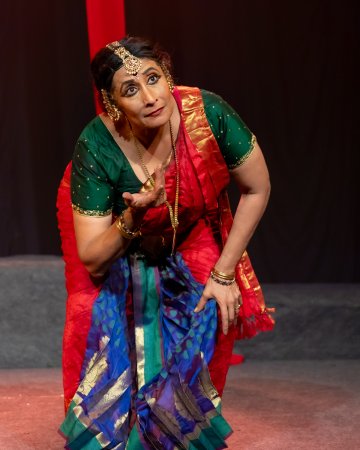
|   |

|   |
Delightful duets; distinct and divergent - Hareesh N. Nampoothiri e-mail: haree@newnmedia.in Photos: Haree Fotografie November 22, 2024 The 'Parampara' segment of the Soorya Festival this year featured mostly duets along with a few thematic productions. 'Neyam' by Manju V. Nair and Jagadishwar Sukumar, and the Kuchipudi duet by Vyjayanthi Kashi and Prateeksha Kashi, with their production 'Chitra Lohita' as the central piece, were presented on two evenings of the ten-day-long festival. A spin-off to the Tataka tale  Neyam Tataka is often portrayed as a cannibal who disrupts yagas and harasses travelers in the Dandaka forest. A demoness, cursed into this form, she is ultimately granted salvation when Rama kills her. 'Neyam - A Tale of Amity' presents this episode in a completely different light. Manju V. Nair and Jagadishwar Sukumar draw inspiration from the poem 'Tataka Enna Dravida Rajakumari' (The Dravidian Princess Tataka) by Vayalar Rama Varma, reimagining Tataka's character and her tragic ending. Even before the poem, there is the Kathakali play 'Tatakavadham', penned by V. Krishnan Thampi, which portrays Tataka as a Dravidian princess. However, the similarities end there. The dance production and the Kathakali narrative take entirely different paths. Coming to 'Neyam', there is no denying that the craft is solid. Manju V. Nair's choreography achieves a perfect blend of nritta and nritya. The production primarily elaborates on the unique connection forged between Rama and Tataka. As they dwell in the forest and revel in nature, the two become companions. The dancers excelled throughout, showcasing elegant footwork and delivering compelling moments with their impressive theatrical skills.  Neyam The music, composed by Bijeesh Krishna, was enchanting, alternating between peppy and evocative tones to effectively set the mood of each scene. Alas, their companionship is unfortunately, short-lived. When Tataka approaches Rama, the sages intervene, urging him to kill her. Reluctantly, Rama obeys, and Tataka, her heart already shattered, accepts her fate as the arrow pierces it once more. The poem and the Kathakali play delve into the underlying politics and cultural conflicts between the Aryans and Dravidians. 'Neyam' doesn't particularly touch upon those aspects. In the Kathakali version, the narrative centers on Rama defending the Yaga, adhering to Aryan traditions that involve the slaughter of cows, while Tataka opposes this practice. Exploring such political undertones may not be viable in the present times, a subtle hint at the conflict of interests could have added depth. Moreover, the climax, where Rama kills Tataka despite their established connection and her peaceful visit, feels hollow. A more nuanced approach - portraying Rama as less of a mere instrument of the sages and Tataka as a resolute figure defending Dravidian traditions - would have been more convincing and impactful. Painting the shades of red Indian myths are filled with tales of bloodshed, yet each one carries its own unique essence. It makes sense to bring these stories together to highlight the core of each. 'Chitra Lohita' conceived by Vyjayanthi Kashi and presented by her alongside her daughter-disciple, Prateeksha Kashi, does exactly that. Beyond the stories of bloodshed, it also explores the redness of Radha's cheeks and the glowing red Sun God, which Hanuman tries to take, mistaking it to be a fruit.  Vyjayanthi Kashi & Prateeksha Kashi Each of the stories undoubtedly holds more depth, but the production presents them in their most concise form, without delving deeply into each one. The pace was fast, and Vyjayanthi Kashi and Prateeksha Kashi captivated the audience effortlessly, switching between characters and executing vibrant footwork in the dance segments. Vyjayanthi impressed in her portrayals of Hiranya and Kali while Prateeksha excelled in bringing Hanuman and Raktabija to life in their respective episodes. Their intuitive connection with both the choreography and each other was clearly evident throughout the performance. Earlier, the duo commenced their recital with an invocation to different goddesses, a composition in raga Revathi following the verses "Deho devalaya prokto...". The concluding piece was 'Kubja' elaborating the story of the hunchbacked devotee of Krishna. This was yet another choreography by Vyjayanthi Kashi, and it was a pleasure to watch both performers gracefully embody their respective characters - Vyjayanthi Kashi as Kubja and Prateeksha Kashi as Sree Krishna. Vyjayanthi's ability to embody the emotional depth of the story enhanced the overall impact.  Vyjayanthi Kashi in Kubja  Prateeksha Kashi in Chitra Lohita The performances took place at Ganesham, the black-box theatre owned by Soorya India, on the 5th and 8th of November, respectively.  Dr. Hareesh N. Nampoothiri is a visual design consultant by profession, an art lover by obsession and an author, writer, photographer, editor, lyricist, and director by passion. He is also the founder and chief editor of Artograph, a bimonthly e-magazine on arts. |